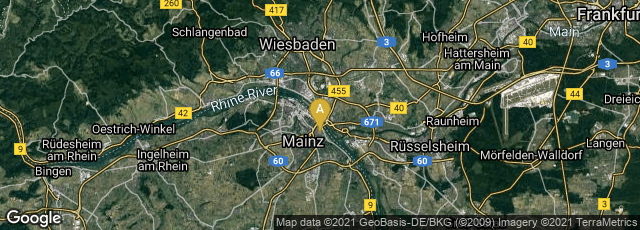

A: Altstadt, Mainz, Rheinland-Pfalz, Germany
On August 14, 1462 banker Johann Fust and printer Peter Schöffer at Mainz issued the fourth printed Bible, and the first explicitly dated Bible, sometimes called the Biblia pulcra because of the new Gotico-Antiqua typeface which Schöffer developed specially for the edition.
After its colophon printed in red, the edition contains the first printer's mark ever used, also printed in red—two linked shields hanging from a branch, the first of which was inscribed with the Greek letter χ for Christ, the second inscribed with the Greek letter Λ (for logos = word). Fust and Schöffer's printer's mark first appeared in a single extant copy of the 1457 Mainz Psalter preserved in Vienna. The other 9 extant copies of that work do not contain the mark. The 1462 Bible is the first work to include the printer's mark in the entire edition.
"Printers' marks had no precedent in text manuscripts, though they had an affinity with notarial signets that had been in use for a long time in legal contracts and official documents. It may seem surprising that, in spite of these early examples, so many incunables were issued without the name of the printer, and often without place and/or date. Since it was not at all common for scribes to sign their names, printers presumably did not consider identification important until they saw in the complete imprint a detail which would increase their sale and satisfy their ego. E. von Kathen made a statisical survey of all the entries in volumes I-VII of the Gesamtkatalog and found in this sample (which covered ca 20% of the total XVth-century production) that up to the year 1480, 57.4% lacked indication of printer, 53% in the next decade, and 35.3% in the last decade of the XVth century" (Hirsch, Printing, Selling and Reading 1450-1550 [1967] 25).
•The lack of printers' names, or even place or date of printing, in so many 15th century printed books created huge research challenges for historical bibliographers of early printing during the 19th and 20th centuries.
ISTC no. ib00529000. In November 2013 a digital facsimile was availablefrom the Bayerische Staatsbibliothek at this link.
Wagner, Als die Lettern laufen lernten. Medienwandel im 15. Jahrhundert (2009) no. 53. Clair, A Chronology of Printing (1969) 11.